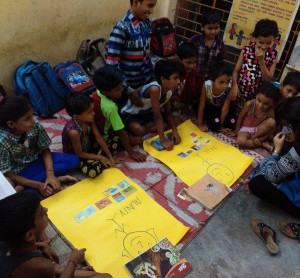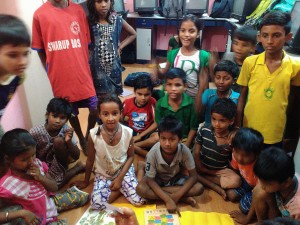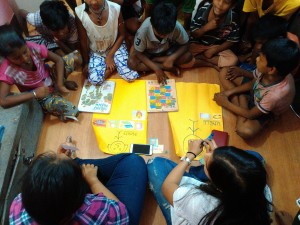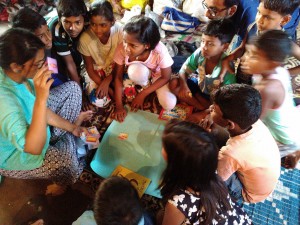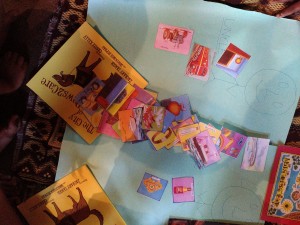As an intern with PeaceWorks—an initiative of The Seagull Foundation for the Arts, one of the projects I worked on was Share Stories Open Minds—the storytelling project for underprivileged children. I visited the centres and observed the sessions. This was done to assess critical thinking in the children— how much they have understood to live with difference and if they are practicing it in their daily activities. I visited four centres over three weeks.
Amherst Street Police station [Nabadisha] Centre: This was the first centre I visited. We had planned an activity for the children where we would be showing them pictures of tools, kitchen equipment, different means of transport etc. With each picture, the children would be asked where it would fit according to work done by either a male person or a female person [‘Aunty’ or ‘Uncle’]. It was a class of fifteen students and the age group was between 5-10 years. The students greeted the activity with lot of enthusiasm. The idea behind this activity was to see how much they have learned from their previous classes and if they agree with the stereotypes present in society. Most of them adhered to the stereotypes but some did not. I noticed that the students who did not follow the stereotypes were influenced by their peers, ultimately agreeing with what the others were saying.
Farshi, the volunteer at the centre narrated two stories on brave women. One was about Thimmakka and another, Kalpana Chawla. While she was narrating the story she said that Thimmakka was childless. Suddenly a student asked that then she will buy a child? This was a very surprising comment but these children stay in slums and some stay on the road — they don’t have proper shelters so that is probably what they see around them. Maybe they have seen human trafficking take place so that is the idea they have in their minds.
Some of the students are young and they all come to the centre just after their school gets over so they are mostly tired. And the little ones fall asleep. They try to concentrate when the stories are narrated but after a while they lose their concentration and reply in chorus. I observed that they did not know about Kalpana Chawla but two people knew about Neil Armstrong, which shows that they are possibly less exposed to female narratives.
This centre is fairly new — storytelling only started in the month of February so the children will take time to develop an interest. I chatted with a boy at the centre regarding the kind of environment he stays in. He told me that he stays in the nearby slum with his parents. His father works in a factory and his mother works as a maid in different households. He is very keen in attaining knowledge and encourages others to study. His sister stays with his maternal uncle and aunt in their village. He told me that his sister studies in a school in the village and his uncle and aunt do not allow her to do any kind of household chores. They encourage her to study. That was something positive to end the day with.
Bhowanipore Police Station [Nabadisha] Centre: The age group of the students varied in this centre, some were 5 years and some were 12 years old. We began the session with an exercise similar to the one we did at the Amherst Centre. A story was narrated to them about a girl named Rajni who was bullied in college because of her short hair. Rajni then started a forum where she asked other students to share their experiences of being victimized for going against the norms of society. The experiences shared in the forum included that of a boy who went for a competition and began crying when he lost. Everybody laughed at him because he cried. Another person shared that how he was humiliated as he carried his mother’s bag to the market.
The volunteers asked the children if they liked short hair on girls. Except for one, everyone else said that they didn’t. Some felt very strongly about the fact that boys have short hair so it does not look good on girls whereas some believed that it is one’s choice. This shows that they were ready to accept change and also respect somebody else’s opinion. The volunteers also asked them to introspect what her parents must have told her to save herself from the humiliation. They replied that her parents must have said that she should grow her hair, should put a wig; with short hair she looks like a boy, she does not look good with short hair. Then the volunteers asked the students regarding the crying incident. The students replied — he lost the competition so he cried; another one said he cried so peopled laughed at him. The volunteer questioned why was the boy who carried his mothers bag teased. The students said that everybody laughed because he carried a bag so he did not look good. Some said that he was looking like a girl with his mother’s bag and that is why people laughed.
They shared their personal stories where they were humiliated. One of them shared his story of being bullied by a group of boys and how he cried but later he shared his lunch with them and became friends. Some shared their achievements as well. The children appeared to be keen on sharing their experiences. After the completion of the story they felt that Rajni was brave and one should not tease others.
Alipore Centre: When I arrived at the centre the students were engaged with their homework together. When we started with the activity everybody enthusiastically participated in it. But I came to know from Anushka, the volunteer at the centre that this was not the case initially. Earlier they had groups — and the girls sat only with girls and the boys sat only with boys— and they wouldn’t communicate with each other but the volunteer in that centre worked on it and the situation changed.
I had a conversation with Anushka about how she worked on this issue and she told me that she narrated them stories about equality and also involved them in group discussions. She planned activities in such a way that every student participates and after three weeks there was a difference. They started sitting together, the set of groups started vanishing and they all mingled with each other. There was a culture of debate—they raised their opinion and stayed true to it—which is a remarkable thing to witness because that is what we want to achieve. We want the children to have their individual viewpoint and not to get influenced by the group.
I came to know from one of the teacher coordinators that some students have developed an interest in artwork, in painting, in drawing, in comic strips and other forms of expression. It’s not that everybody is participating but some are which is a healthy growth. Also, I observed that the children do not fall into the stereotypes that are constructed in the society. This conclusion came from the activity that we performed where we showed them some pictures and asked them to identify it with the work done by male or female. And their answers were very inclusive and they thought that most of the work is done by both. They absorb what they see around them and so their observations are based on that.
Anushka developed an idea for another session She got sticky notes and she stuck them on the back of the children. Then the children had to draw something on the sticky notes that were stuck on each other’s back. Some drew houses, some drew trees. After the drawing was over they had to build stories based on the drawing. This became an interactive session where they used their imagination to develop stories.
The volunteers then introduced the children to the idea of metamorphosis. They told them to draw a fish and then asked them to change it into a kite from which they had to develop and narrate a story. I believe it was an intelligent and fun way to teach them the concept.
Kalighat Centre: I had a very different experience in this centre. Here the children did not sit quietly and listen to the story being narrated. They began narrating their own stories in the middle of the one being narrated by Paroma and very often broke into scuffles.
The had a mixed response to the activity where pictures of tools, utensils, modes of transport etc. was shown to them and asked which category—male or female—it comes under. Some believed that all kinds of work could be done with both whereas some believed that only women do certain work and others believed that is done by men. They built their opinions on what they see around them. For instance, when showed the picture of the train some of the girls said that their teacher uses it for her commute but some of the boys said that they have seen it men using it to reach their office.
The children appeared to lack patience with each other. I think more stories based on patience and tolerance need to be narrated to them. Activities can be formulated where the students can be taught the importance of teamwork. The idea of inclusiveness is there within them it just needs to be channelized properly.
Paroma then played some some fun games with the children which they enjoyed.
– Rupsha Paul

